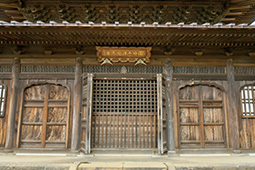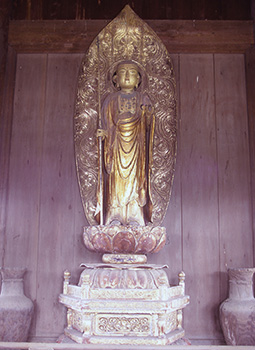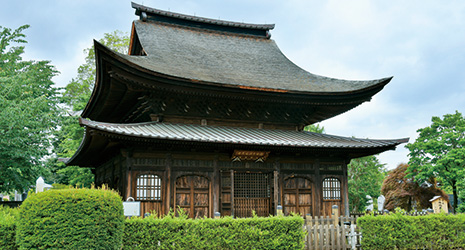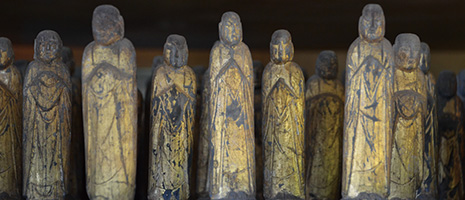INDEX

Yumiranma transoms and katomado windows 
The main Jizo statue in the Jizodo
- PREVIOUS
- NEXT
July 2020
Jizodo at Shofuku-ji Temple

The early fifteenth-century Jizodo (Jizo Hall) at Shofuku-ji Temple in Higashimurayama City, Tokyo, is a national treasure revered for its quintessential “Zen-style” architecture and for housing around 900 Jizo statues.

Hojo Tokimune (1251–1284), the eighth regent of the Kamakura shogunate (late twelfth century to 1333), is remembered as a great samurai warrior who led Japan’s defense against the Mongol invasions, but also as a deeply devout follower of Zen Buddhism. It is said that Tokimune fell ill while practicing falconry in Higashimurayama City, a suburb of present-day Tokyo, but in a dream he took medicine given to him by the Jizo Bodhisattva, and when he awoke he was healed. Temple legend describes how Tokimune was so moved by his recovery from illness that he founded Shofuku-ji temple.
In one corner of Shofuku-ji’s grounds is the Jizodo (Jizo Hall), where a large Jizo statue is enshrined as the principal object of worship. The Jizodo is an approximately 10-meter-tall, single-story wooden structure. The Zenshuyo (Zen-style) of its construction, as epitomized by the steep upward curves at the four corners of its roof, was introduced from China along with Zen Buddhism in the Kamakura period. The building’s yumiranma, transoms with wave-shaped ornamentation to let in sunlight, and katomado, windows with a rounded design on the upper frame, are two more characteristics of traditional Zenshuyo architecture.

During the two years of dismantling and repair work which began in 1933, ink-drawn calligraphy was found on some of the building components, proving that the Jizodo was built in 1407. The Jizodo was later designated as the first national treasure building in Tokyo in 1952. This is because the year of construction was clear and due to the fact that it is an extremely precious building in the traditional Zenshuyo architectural style which remains mostly as it was when built.
The Jizodo is also known as “Sentai Jizodo” (1,000 Jizo Hall), as approximately 900 ancient wooden Jizo statues remain and stand on either side of the main Jizo statue inside the hall. Many of them are between 15 and 30 centimeters tall, and among them, many were dedicated by farmers around the eighteenth century when large-scale agricultural development took place across modern-day Higashimurayama City. It is said that, at that time, when people had a wish, they would borrow one of the statues in the Jizodo and take it home, and when their wish came true, they would bring the statue back along with a new statue to dedicate. It is thought that this is how there came to be close to 1,000 statues, as the statues, dedicated by the people, slowly accumulated.

To this day, many people in Japan have a deep affection for the Jizo Bodhisattva, a deity believed to protect and rescue people from all manner of difficulties.
The Jizodo is only open to the public a few times each year, but the quaint exterior, which has withstood wind and rain for about 600 years, can be viewed at any time. Even today, many people visit the Jizodo and ponder on these traces of the deep faith of those from the past.
- PREVIOUS
- NEXT

